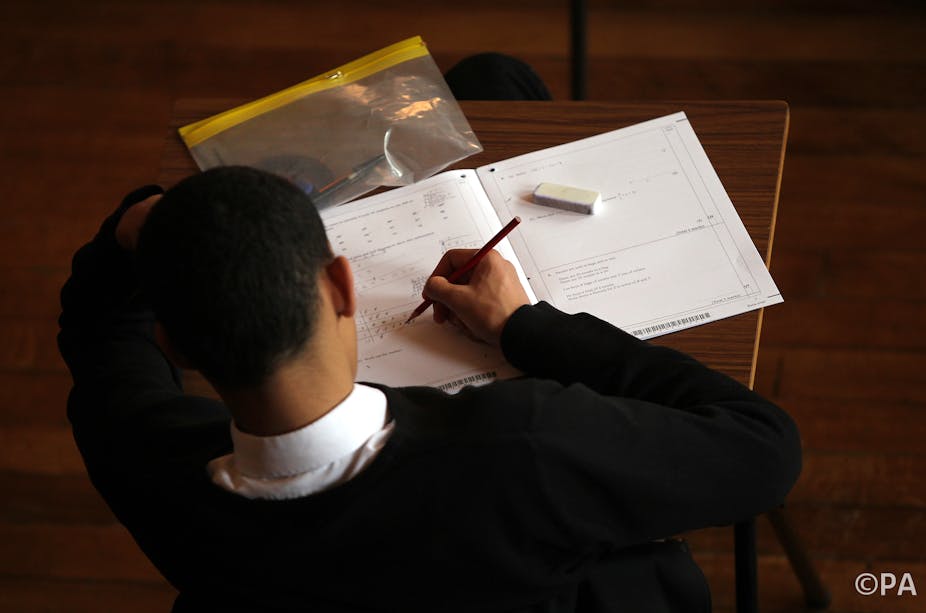Children’s access to high grades at GCSE is determined by our examination system, which assigns grade limits in some subjects. Known as tiering, this means that some 16-year-olds sit a foundation GCSE exam paper in which the top possible grade is a C, while others sit a higher paper where a grade A* is possible.
There has been much debate about whether tiering should be removed altogether, something that the former secretary of state for education, Michael Gove, advocated because of its promotion of a culture of low expectations. How Gove’s views on tiering tally with his short-lived policy to reintroduce O-level and CSE-style papers, sat by different ability students, is a mystery. The deputy prime minister, Nick Clegg, strongly opposed those more extreme policies.
The outcome so far is a more moderate change to tiered exams instead. I applaud the removal of tiering in GCSE English literature, English language and geography as part of the examination regulator, Ofqual’s, exam reforms. But tiering for maths and science exams remains. And Ofqual has yet to announce their policy for tiering in French, German and Spanish GCSEs, although they have consulted on keeping it in those subjects too.
Aims of tiering blurred by reality
Tiering was introduced when GCSEs replaced O-levels and CSE exams in 1988. GCSEs were brought in to create a single examination system for all, yet when it came down to it, reformers baulked at a single exam for all students in every subject.
Tiered exam papers were intended to address the problem of educating the masses, so that lower ability children would not have the soul-destroying experience of sitting an examination where they could only answer a few questions, then be left looking out of the window until they were allowed to leave the exam hall.
But in practice, examiners set exams that were too similar across the tiers, so the benefits of sitting the foundation exams never really materialised. Examiners could not bring themselves to set papers that were easy enough for the lower ability students. We can see this from the fact that the marks needed to get, for example a grade C, are not very different in foundation and higher tier exams.
In GCSE English exams, the foundation tier was sometimes slightly harder at grade C because examiners used more words to explain the instructions, which increased the reading demands of the question paper. But in subjects like English literature or history, the same questions can be set for all ability groups and students can be distinguished by how well they respond. To remove tiering from these subjects is a no-brainer.
Teachers favour tiering in some subjects
In other subjects, such as maths and science, the best students are distinguished by being able to tackle the most difficult set questions. Here, the need for tiered exams could be seen as more understandable. The majority of maths and science teachers surveyed in an unpublished 2001 study I worked on for the Joint Council for General Qualifications, preferred to keep tiering.
Part of this is because a high proportion of maths and science classes are taught in ability groups. Research has shown that the higher ability groups are typically allocated the best qualified, more enthusiastic teachers who put in more time and effort.
Students primarily get into these high-ability groups by doing well in exams taken earlier, some of which are also tiered. And our 2001 research showed that it was pretty unusual for schools to change a student’s ability group, for logistical reasons. Once you are there, you are stuck. In some subjects, such as maths, some of the material is not taught to foundation tier classes. You might have to go beyond what you were taught in school to move up a class.
We also know from our 2001 work that not many students performed so well on foundation tier exams that they would have been likely to get a higher grade if they had been entered for the higher tier paper. Likewise, not many students walked away from the higher tier exams without a grade who would have got something if they had sat the foundation tier. But of course there are some people every year in each of those situations.
Demotivating consequences
What’s clear is that the combined effects of ability grouping and exam tiering are more insidious than restricting grades on the day of the exam. As you might expect, students say that knowing that they cannot get the highest grades is demotivating.
Teachers are also aware of this. Yet the decisions they make about which paper a student will sit are influenced by more than just academic attainment – such as the usual suspects of attitude, gender, ethnic group and socioeconomic status.
Given that Ofqual has decided that tiering is here to stay in maths and science, for now at least, we really should seek to ensure that foundation exams are designed to be a better experience for the less able. We also need to make sure that students can move more freely move between ability groups in schools. Otherwise, ability grouping and tiering combine in our education system to compound existing social inequalities.

